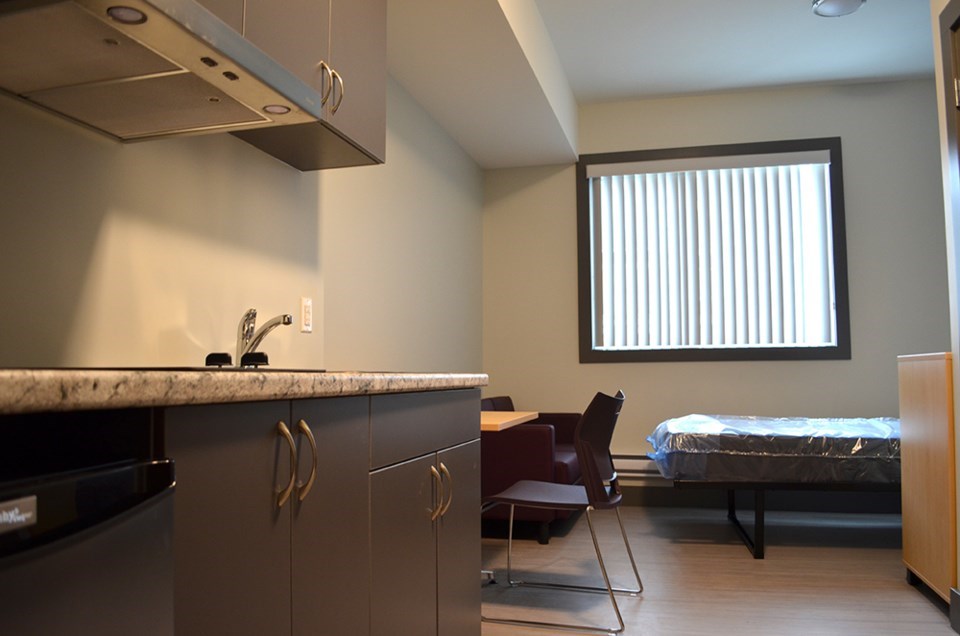Among the challenges listed by Squamish Helping Hands is the need for a long-term destination for people exiting transitional housing.
While presenting to District municipal council on Jan. 23, the executive director of Helping Hands, Lori Pyne, recounted a story of a resident at Under One Roof.
Pyne said the resident, an ex-logger who has spent his whole life in Squamish, voiced some of his concerns.
"He's not just fulfilling his basic needs, he's also self-actuating and gaining self-esteem at Squamish Helping Hands," she said.
"I had a nice little visit with him in his room … And he said, 'I don't want to leave my home.'"
Pyne said this resident always feels like he has to leave.
She said that the Under One Roof facility was envisioned as transitional housing. Tenants with entrenched substance use and mental health issues are on the second floor, moving to the third floor. Then, tenants living on the fourth floor eventually integrate back into society from the fourth floor.
"But there is nowhere to transition for these folks, and, so, they're getting stuck there. And this is really what we're working on in our new strategic plan," Pyne said.
This was one of many points raised during the Helping Hands' meeting with municipal council.
By the numbers
Included in the meeting agenda was a report with the latest set of statistics from society, which often used data from 2022.
The total operating revenue for Helping Hands was $2.79 million that year, with 70% of the money coming from the government.
Total expenses were also about $2.79 million, with 67% spent on wages.
These amounts did not include the total amount of donated and rescued food, which totalled about $713,000.
Numbers from the emergency shelter program were also made available.
According to the report, about 73% of the users are male. There were 97 people who used the shelter in 2022, 5,510 emergency shelter stays in 2022, and 70 nights when the extreme weather program was open between 2022 and 2023, among other things.
OPS
Another highlight of the meeting was a discussion about the overdose prevention (OPS) site located near the Under One Roof building.
In the first half of 2023, the average amount of visits per day was 55, up from 27 the previous year.
During the council meeting, Pyne said that, as of now, there are about 90 visits per day, though these are not all from separate individuals. Typically, in a month, there will be about 10 overdoses. About 30 medical incidents per month require a visit from paramedics or firefighters.
She said it would be advantageous to the community if the overdose prevention site was operating 24 hours a day.
There is typically an uptick in visitors to Under One Roof when the overdose prevention site is closed, she added.
One potential advantage of keeping the overdose prevention site open is that emergency responses are concentrated in one area, rather than spread throughout the community. This could make it easier for paramedics to respond, Pyne said.
"The scope of the overdose prevention site is really important too because it's a warming centre, it's a place for food, it's a place to socialize, it's a place for sometimes when you're restricted access to other places, it's somewhere where you can go," added Jonathan Hand, a manager with Helping Hands, who was also presenting at the council meeting.
"I think the overdose prevention site saves lives, and then it also creates this amazing space that's really, really useful. People have said if it was open 24 hours, it would be used 24 hours."
Pyne also added that there's a community need for shelter for low-income seniors and people coming out of recovery from substance use issues.
"Although we're not a recovery facility, people, when they come out of recovery, are the most vulnerable to relapse and they're having to stay at the shelter because there's nowhere else," she said. "Most people are homeless when they leave recovery."
Encampment
There was also discussion about tents being erected by some people without homes near Under One Roof.
"It's important for everyone here to know that those individuals living there are very complex. They can't be inside because of their substance use or mental health," said Pyne.
"They either can't be inside because they're so complex or don't want to follow the rules that we need to follow to keep the staff and community safe.
She said Under One Roof has not been full all winter, so those individuals chose to stay outside, sometimes in -25 C weather.
Pyne said Helping Hands does a weekly cleanup and offers support, shelter and food to those in the encampment.
The entire presentation can be viewed on the District of Squamish’s YouTube channel.




